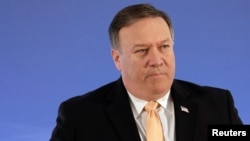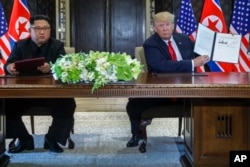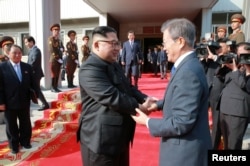Amid concerns North Korea appears to be bolstering — rather than dismantling its nuclear and missile facilities, U.S. Secretary of State Mike Pompeo this week will make a third trip to Pyongyang.
Pompeo, who made his initial visit to North Korea earlier this year as director of the Central Intelligence Agency, is scheduled to be in Pyongyang from Thursday through Saturday.
His trip follows discussions Sunday at the Korean demilitarized zone between U.S. Ambassador to the Philippines Sung Kim and North Koreans.
It was the first time U.S. and North Korean officials are known to have met since President Donald Trump held talks with Kim Jong Un on June 12 in Singapore.
“We're continuing to make progress. We had good meetings yesterday,” White House Press Secretary Sarah Huckabee Sanders said in response to a VOA question at Monday’s briefing. “The secretary of state will be there later this week to continue those discussions.”
Reports on North Korea’s programs
Sanders, however, declined to discuss reports citing both U.S. intelligence officials and commercial satellite imagery that North Korea continues to improve its nuclear and long-range missile programs.
Trump recently declared “there is no longer a nuclear threat” from Pyongyang, due to his “great success” negotiating with North Korea’s leader.
Satellite imagery and U.S. intelligence officials, contradict that assertion, revealing evidence of recent work at multiple secret sites in North Korea connected to the country’s production of enriched uranium for nuclear weapons.
North Korea also appears to be finishing an expansion of a ballistic missile construction site in Hamhung.
WATCH: US-N. Korea relations
The Chemical Material Institute is known for making carbon composite parts for re-entry vehicles of solid-fueled missiles, Dave Schmerler, a research associate at the Monterey Institute of International Studies, said.
"This site is the almost complete expansion of the CMI that Kim was shown last year,” Schmerler tells VOA. “While the North Koreans were talking with the U.S., this site was undergoing continued construction.”
When contacted by VOA, officials at U.S. intelligence agencies and other government organizations that keep track of North Korea’s development of weapons of mass destruction declined to dispute the assertions in recent news reports that intelligence officials have concluded Pyongyang does not intend to fully surrender its nuclear stockpile.
North Korea, according to NBC News and The Washington Post — citing discussions with U.S. intelligence officials — is seeking to deceive Washington about the quantity of nuclear weapons and ballistic missiles it possesses and the scope of related facilities.
Underground uranium site
Also among the facilities under scrutiny is a secret underground uranium site at Kangson, believed to have twice the enrichment capacity of the well-known Yongbyon Nuclear Scientific Research Center.
Commercial satellite imagery more than a week after the Trump-Kim June 12 summit also indicated improvements to the infrastructure at Yongbyon “are continuing at a rapid pace,” according to the 38 North website, run by the Stimson Center.
Prior to the Trump-Kim summit in Singapore, North Korea announced the demolition of its Punggye-ri nuclear test site, where it conducted six announced atomic underground detonations.
Experts have expressed skepticism that the demolition, which North Korea allowed foreign television to videotape from a distance, was much beyond the symbolic.
Subsequent satellite imagery, according to 38 North, showed the Punggye-ri headquarters building and support camps “apparently untouched.”
North Korea also appears to have blown up a missile test stand north of Kusong. But “there have been no alterations or activity akin to dismantlement to any of the six known launch and engine test facilities and two ejection test stands,” according to 38 North.
Analysts say none of this should be surprising, especially since what is meant by “denuclearization of the Korean peninsula” is interpreted differently in Pyongyang than in Washington and Seoul.
Kim, during his meetings this year with South Korean President Moon Jae-in, committed “to denuclearize South Korea by removing the U.S. nuclear umbrella and its forces from the Korean peninsula,” retired U.S. Air Force Lt. Colonel Tara O, an adjunct fellow at the Pacific Forum, tells VOA.
“As the intelligence and the commercial imagery show, Kim did not mean he’s committed to denuclearizing North Korea,” says O, author of the "The Collapse of North Korea: Challenges, Planning and Geopolitics of Unification.”
Noting eight failed agreements with North Korea in the past, the Heritage Foundation's senior research fellow for Northeast Asia, Bruce Klingner, says, “I’m cynical. I’m skeptical. But I’m hopeful that this time is different. So, we have to go in with our eyes open. But we also need to remain wary that North Korea may try to cheat again.”
Klingner tells VOA’s Korean Service that while Trump and Kim made no concrete deal in Singapore, recent North Korean activities “certainly would seem to be a violation or counter to the spirit of the Singapore agreement, as well as the inter-Korean agreement. It certainly doesn’t seem consistent with the actions of a government that’s preparing to fully denuclearize.”
National Security Correspondent Jeff Seldin and VOA's Korean Service contributed to this report.












